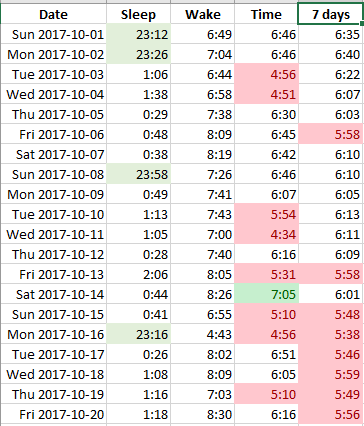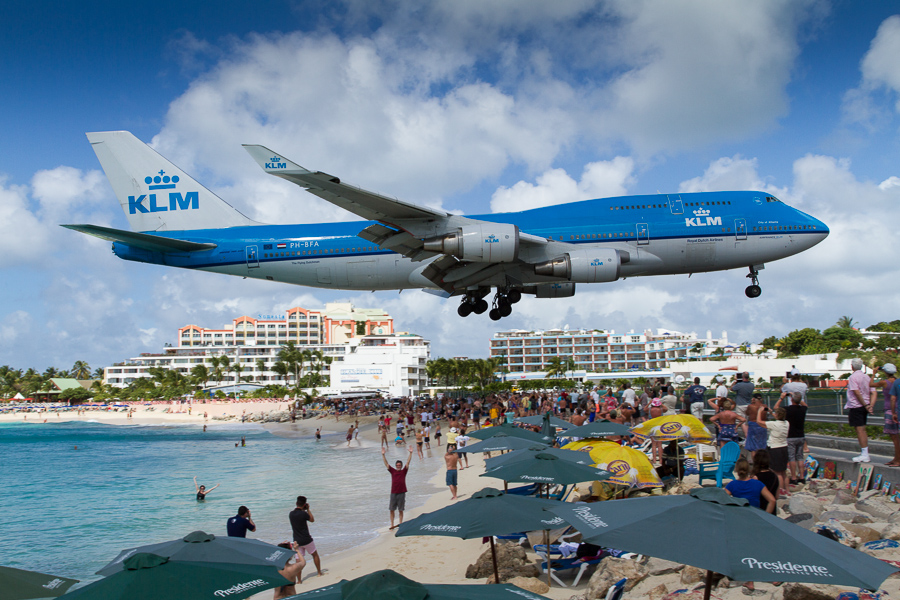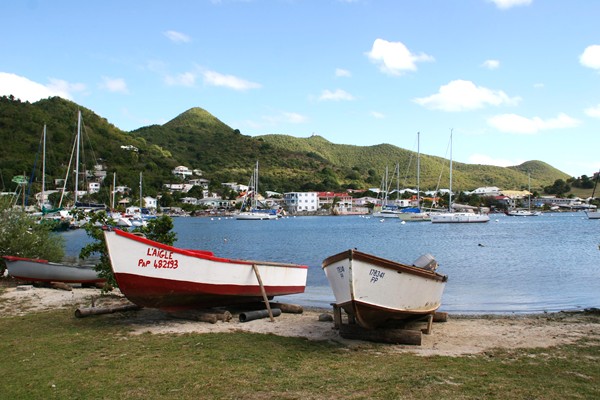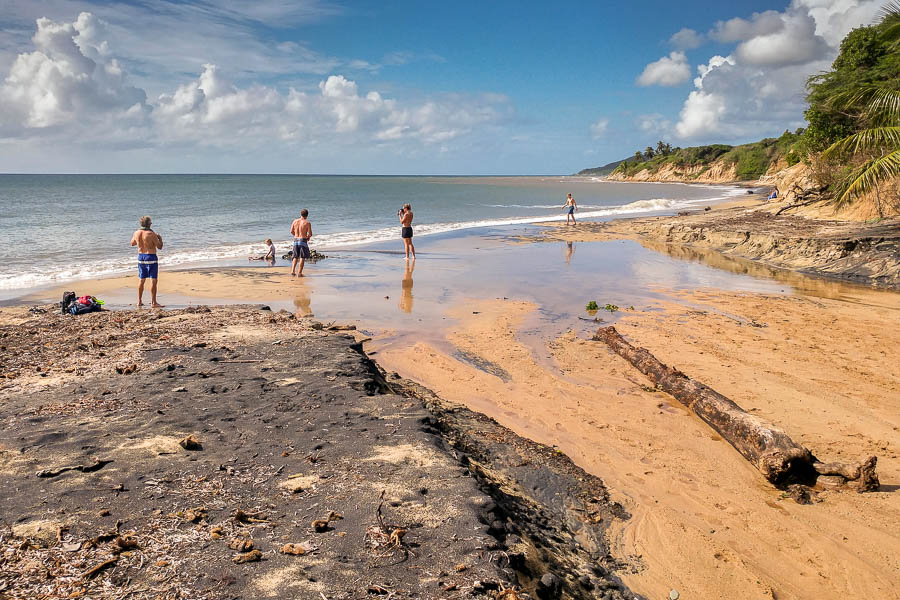I'm excited about my new project, but as we ramp it up, I'm becoming aware of a cost: sleep. And that's not good.
Thanks to my Fitbit, I have a pretty good idea of how much I'm sleeping. Here's what October looks like so far:

The 11th through 13th and the 16th through 18th were travel days. And then on the 17th (the "wake" column of the 16th) I had to get up at an ungodly hour to get to the San Antonio MEPS by 6am.
I think this will settle down quickly, but wow, I'm really feeling it today.
I'm about to fly to San Antonio for another round of researching how the military tracks recruits from the time they get to the processing center to the time they leave for boot camp (officially "Military Basic Training" or MBT).
I have some stuff to read on the plane:
OK, off to K20. Or K18. Or wherever my plane has got to.
On the southwest coast of Ireland, County Kerry's local newspaper warns that post-tropical storm Ophelia will hit within the hour with "violent and destructive gusts forecast with all areas at risk."
Galway schools are closed an Irish defence forces are being deployed throughout the area:
The Department of Education has ordered schools across Galway to close tomorrow as a red weather warning remains in place for the county.
It follows a special meeting of the Government Task Force on Emergency Planning this afternoon to discuss preparations for Hurricane Ophelia.
GMIT is also to close all of its campuses across Galway – while NUI Galway says it is currently assessing the threat and will make a decision at 7 this evening.
Meanwhile, the City Council says Hurricane Ophelia does not currently pose a strong flood risk.
In a statement, the local authority says while there will be a storm sea surge in Galway Bay, the overall tidal level is predicted to be below the critical level for flooding.
It adds it will continue to monitor the situation and further defences and other measures will be put in place if required.
Meanwhile the storm track seems to have shifted west, so that Islay and Campbelltown are not directly in Ophelia's path; but not entirely safe either:
Three battalions of soldiers are on permanent standby to deal with major incidents in the UK, but the Ministry of Defence said no specific requests had yet been made of them by local authorities.
The Republic of Ireland's Met Office predicts coastal areas will be hit by winds in excess of 80mph (130km/h) from 09:00 BST on Monday until Tuesday and is warning against unnecessary travel.
Gerald Fleming, head of its general forecasting division, told Irish broadcaster RTE: "The track is very consistent [and] has been for days.
"The strongest winds [will be] along the south coast.
'Huge contrasts'
"That'll be tomorrow morning, and it'll track up the centre again, going up along the western part of the country."
BBC Weather said Monday would be a "day of huge contrasts" with the strong gusts of wind travelling over the Irish Sea and heading north to central and southern Scotland, sparing eastern parts of the UK.
Eastern England is instead expected to enjoy unseasonably warm weather, with temperatures of 22C or 23C on Monday - compared with an average for mid-October of 15C.
Highs of 24C were recorded in the region on Saturday as some parts of the country basked in a "mini heatwave" thanks to warm air brought by Hurricane Ophelia
I hope the people I met in Ireland and Scotland over the years get through this once-per-century storm with their wits about them—and their houses. Good luck.
Imagine the largest office building (in land area) you've ever been in, add a small shopping mall, four food courts, and the security that demonstrates exactly how silly and ineffectual airport security is, and that's the Pentagon.
I'm in a little island that's like an anti-SCIF (Secure Compartmented Information Facility). We're in the one unclassified office in the ring, complete with unclassified Internet service, and because of that, behind two steel doors and in a Faraday cage. And it's literally the only place we're allowed to take pictures, which is sad because every hallway in the building is a museum exhibit. It's weird.
That, and we can't go to the bathroom without an escort, makes this a very strange day indeed.
Also, it's like an ongoing pop quiz in uniform insignia recognition. And I'm still having problems with upper enlisted ranks.
Home tomorrow, after a visit to a military facility outside Baltimore.
The Islay-based Port Ellen distillery closed in 1983, leaving only a few hundred barrels scattered throughout Scotland's blenders, and a few thousand bottles which now sell for upwards of £1,000.
Diageo, which bought the Port Ellen Maltings in 1987 and all of the original Port Ellen whisky stocks, announced yesterday that it will re-open the brand in 2020 with a £35m investment:
Multinational drinks company Diageo—which owns 28 malt distilleries and one grain distillery in the country—announced that it will invest £35 million (about $46.1 million) to reopen Port Ellen Distillery on Islay and Brora Distillery on the east coast of the northern Highlands. The two single malt distilleries closed in 1983, during a period of decline for the scotch industry. The process of reopening—which includes planning, design, and construction work for both distilleries—will take up to three years. Distilling is slated to begin no later than 2020.
According to Dr. Nick Morgan, Diageo’s head of whisky outreach, discussions about reopening the distilleries have happened periodically for the last 20 years. “We take a very long-term view of the scotch whisky market—you have to for planning and inventory and investment purposes,” he says. “We invested a billion pounds about five or six years ago in upgrading our production facilities, particularly to meet long-term demand that we forecasted for blended scotch whisky. Building on the back of that, we feel that the situation for scotch now is very bright…We felt this was the time to do something like this, with more of a single malt scotch whisky focus.”
While on Islay, I had the opportunity to sample an original Port Ellen dram. I'm looking forward to having another one...in 2030.
(Yikes. I'll be 70 before their whisky is ready...)
Pilot Patrick Smith writes an ode to Maho Beach, Sint Maarten, which remains closed after being partially destroyed by Hurricane Irma three weeks ago:
St. Maarten — or St. Martin — is part French and part Dutch. Princess Juliana (SXM) is in the Dutch section, and Maho sits just off end of runway 10. And when I say “just off,” I mean only a few hundred feet from the landing threshold. As arriving planes cross the beach, they are less than a hundred feet overhead. For an idea of close this is, you can check out any of a zillion online pics. Like the one above. Or this one, or this one, or any of hundreds of YouTube videos. Unlike so many other scary-seeming airplane pictures you’ll come across, they are not retouched.
Thus, planespotting at Maho beach is an experience unlike any other in commercial aviation. Not that you need to be an airplane buff to enjoy it. For anybody, the sights, sounds, and sensations of a jetliner screaming overhead at 150 miles-per-hour, nearly at arm’s reach, are somewhere between exhilarating and terrifying.
This is what he's talking about:

Carl Abbot, writing for CityLab, discusses Blade Runner's impact:
Blade Runner fused the images, using noir atmosphere to turn Future Los Angeles into something dark and threatening rather than bright and hopeful. Flames randomly burst from corporate ziggurats. Searchlights probe the dark sky. But little light reaches the streets where street merchants and food cart proprietors compete with sleazy bars—a setting that Blade Runner 2049 revisits. The dystopic versions of New York in Soylent Green and Escape from New York are set in a city crumbling from age and overuse. In contrast, Blade Runner uses the imagery of the future for similar stories of deeply embedded inequality.
When it comes down to it, of course, there’s more fun and schadenfreude in imagining trouble striking a big city than a small town. Terminator 2: Judgment Day would not be half so exciting if T-1000 chased Arnold Schwarzenegger along the banks of the puny Miami River in Dayton, Ohio, rather than the concrete arroyo of the Los Angeles River. In the 1980s, the fictional destruction of New York was old hat. Los Angeles was a relatively fresh target and, for the film industry, a logistically convenient one. Moviegoers were increasingly willing to disparage it, too.
Blade Runner was a catalyst for a dystopian decade that was accentuated by the rioting and violence that followed the April 1992 acquittal of police officers accused of beating Rodney King. Moviegoers would soon get Falling Down, whose filming was interrupted by the Rodney King riots, Pulp Fiction, and Independence Day, with its total obliteration of the metropolis. In print in the early 1990s were Neal Stephenson’s Snow Crash, Cynthia Kadohata’s In the Heart of the Valley of Love, and Octavia Butler’s Parable of the Sower, all depicting a near-future Los Angeles fragmenting into enclaves and drifting toward chaos, capped by Mike Davis’s The Ecology of Fear.
I've got tickets to Blade Runner 2049 already. Can't wait.
The New York Times talked to people on the American island of Vieques and has this report on the devastation caused by Hurricane Maria two weeks ago:
The 9,000 people living on this island eight miles east of the Puerto Rican mainland have been largely cut off from the world for 11 days since Hurricane Maria hit, with no power or communications and, for many, no running water. People scan the skies and the sea hoping to sight the emergency aid that has been arriving drip by drip, on boats, in helicopters or in the bellies of eight-seat propeller planes.
“We’re on this island, we can’t get off it,” Aleida Tolentino, 56, said on Saturday, as she gazed out over the brown hillsides of uprooted trees and branches stripped of every leaf, with rain rolling in from the east.
The grinding lack of electricity and communications services has created archipelagos of isolation across Puerto Rico. Dozens of towns and neighborhoods, from the coffee-growing mountains to the industrial shoals of the capital, are now virtual islands unto themselves, stranded by destroyed roads, downed cables and splintered cellphone towers.
Even death is an emergency. On Saturday morning, Marlon Esquilín, the funeral director in Isabel Segunda, opened the doors of his hearse to pull out the blackbagged body of an older woman who had died of natural causes the night before.
Someone stole his generator, so he has no power to embalm bodies, and no way to keep them cold in storage. The hospital’s backup generator was also stolen, he said, so he cannot keep bodies there either.
The island has been blasted back to the 19th Century. If only it were part of the United States, then maybe we could help them. Oh, wait...
Republican Illinois governor Bruce Rauner, the best governor we have right now, vetoed a bill that would have required companies to get affirmative consent from consumers before selling their geolocation data:
“The bill is not overreaching,” said Chris McCloud, a spokesman for the Digital Privacy Alliance, a Chicago-based nonprofit advocating for state-level privacy legislation. “It is merely saying, ‘If you’re going to sell my personal geolocation data, then just tell me upfront that’s what you are going to do so I can make a decision as to whether I want to download this app or not.’ ”
The Federal Trade Commission has issued general guidance, and there are a variety of industry self-regulatory codes of conduct, from automakers to online advertisers, but federal law does not provide clear geolocation privacy protection.
The online advertising industry increasingly depends on tracking consumers to serve up lucrative and effective targeted ads. Data collection enables advertisers to learn everything from your search habits and recent purchases to where you travel, often in real time.
Remember: you're the product, not the customer. And that's how Republicans like it.
Two photos from Caribbean islands that will probably never look this way again.
Sandy Ground, St. Martin, February 2009:

Playa Negra, Vieques, Puerto Rico, November 2016:

I hope they can rebuild quickly.